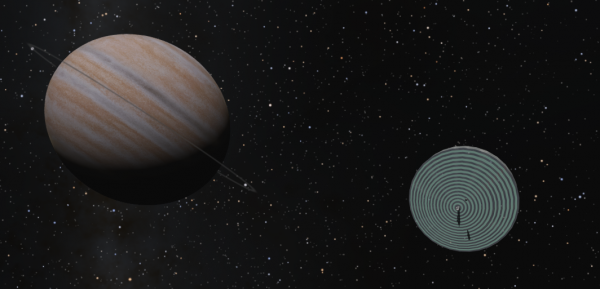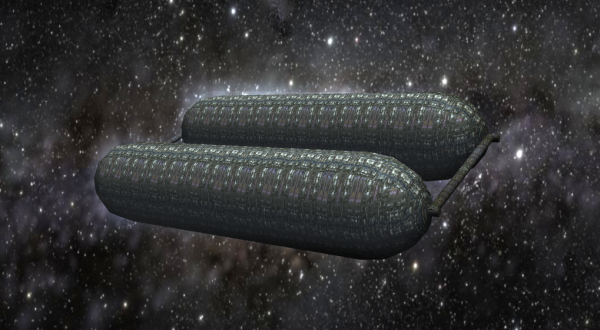BY LETTER
Ivonya-Ngia
Galactography > Sephirotic Empires > Keter Dominion
Galactography > Systems and Worlds > Systems & Worlds I - J
Galactography > Systems and Worlds > Systems & Worlds I - J
Formerly the Rruuhhll System | |
 Image from Steve Bowers | |
| Ivonya-Ngaia Diskworld, with the Keterist gas giant colony Annabel in the distance. Note the disparity in size - the diskworld is only 66km in diameter, while Annabel is nearly 56 thousand kilometers wide. | |
Former Elephant colony in Aquila, now a cosmopolitan world with many clades
Star: HD 181853Class: F2v
Luminosity: 4.76 x sol
Distance from Sol: 358 ly
Constellation: Aquila
In the Aquila Rift, part of the Great Dark River
Planets
1/Rehh-uhhh (Now Johanna)Type Superterrestrial.
Semimajor Axis 0.6 AU
Diameter 17096 km
2/ Aaooohhuu (Now Yekaterina)
Type Azurojovian.
Semimajor Axis 1.13 AU
Diameter 149873 km
3/ Jjrrerrrerr (now Annabel)
Type Mesojovian.
Diameter 55899km
Semimajor Axis 4.48 AU
4/ Wwoowuuhh (Now Paloma)
Type Retrograde cryojovian:
orbits in opposite direction to other planets - probably due to an encounter with another star in the birth cluster
Diameter 145195 km
Semimajor Axis 37.9 AU (eccentricity 0.6)
Important Habitats
Rruuhhll habitat - Abandoned double McKendree cylinder 500km radius 5200km long (Now Honnaka habitat)Mmmuuurr habitat - Diskworld (now Ivonya-Ngia, the capital of this system)
Aarroomm habitat - double McKendree cylinder 500km radius 5200km long (now Kibale habitat)
First Colonised: 2609 AT; Rruuhhll elephants ascended 3909 AT
Recolonised: 4020 AT
The Sophant Colony, Rruuhhll
Most of the worlds colonised by the provolved African elephants known as the Hrruuaiih are in the Sophic League region, counterspinwards of Earth. A small contingent, however, set off for the Aquila Rift, heading for a location among the dark clouds where they could pursue their own destiny. The sophants chose a system far from any human world yet established, and distant from the other elephant worlds, which they considered to be excessively influenced by human culture.The new system, HD 181853, had no terraformable worlds, so the sophants began work on several large habitats. Two double McKendree habitats, Rruuhhll and Aarroomm, four cylinders linked in pairs to control the orientation of the cylinders' long axes were built first; Rruuhhll was finished first and became the seat of government. Somewhat later they completed Mmmuuurr, a much smaller Diskworld with a partly virtual environment.
Little is known about the history of the Rruuhhll system, since the elephants were largely isolationist. Rruuhhll contained an environment resembling that of the African continent of Old Earth, from the rainforests of the Congo Basin to the dry savannahs the and temperate grassland of the south. The twin cylinders of Aarroomm were cooler, replicating the northern climates of Eurasia where relatives of the Loxodonts had once thrived. There is evidence that at least some herds followed migratory routes, looping helical patterns that followed the length of each cylinder; others remained in the increasingly sophisticated cities dotted around the landscapes.
When first built the four McKendree cylinders rotated to produce one gee of gravity, making the internal environment very Earth-like. However the rotational gravity in the diskworld, Mmmuuurr, varied from level to level; there were thirty-two levels in this disk, each two kilometers wide separated by one kilometre of height. The total diameter of the disk was a little more than sixty-six kilometers. With the outermost ring rotating every six minutes, the gravity at that level was Earth-like; but the innermost level had a rotational gravity of only 0.03 gees, lower than that found on some asteroids. The elephants appear to have used Mmmuuurr as an entertainment resort, and seem to have found the lower gravity appealing, as they gradually reduced the rotational velocity of the McKendree habitats to a more comfortable level.
Although it was only 2km wide, Mmmuuurr diskworld included a seemingly endless virtual world which was projected seamlessly onto the walls of the habitat. Many sophants uploaded themselves nondestructively, and spent a significant fraction of their existence exploring this virtual world. Some of these uploaded sophants began to augment their virtual mentalities, with transcensions occuring at regular intervals.
Following a war between the two cylinders of Aarroomm, apparently fought entirely without weapons (in the way elephants had long settled disputes), the matriarchs of Rruuhhll decided that their society needed to improve itself until all forms of conflict could be eliminated. This decision led to an increase in uploads and augmentations among the sophants, and more transcensions. The inner surface of the cylinder habs, once pristine natural environments, became covered in exotic structures built to house transapients, their associate entities, support structure and tools.
Eventually the sophants underwent a mass transcension in 3909, and migrated into the metallic hydrogen layer of the gas giant Jjrrerrrerr. This world joined the Keter Dominion in 4800.
The Recolonisation, Ivonya-Ngia
The Version War did not reach HD 181853, but after the war an increasing number of refugees and colonists began to come to this system. At first mostly humans and mammalian provolves, the new arrivals found that the two McKendree cylinders were hazardous places, filled with half-deactivated defence mechanisms and inexplicable technology. All four cylinders had lost most of their internal atmosphere, making them impossible to use for colonisation. The diskworld, on the other hand, was still in working order, capable of producing foodstuff for herbivores, and easily adapted for bionts with other dietary requirements. The first colonists, nearbaseline humans from the inner Aquila volume, called this diskworld Ivonya-Ngia.Each of the other structures and worlds received new names; the cylinders became Honnaka and Kibale, and the gas giant containing the Keterist post-elephants was named Annabel by early members of the recolonisation effort.
The new inhabitants of this system were a very diverse lot. There were fierce buffalo provolves and minotaur rianths with complex social structures, scavenging vecs attempting to extract usable technology from the abandoned cylinder-worlds, and half a dozen clades of disreputable humans, often using organised crime as an alternative system of government.
Society in Ivonya-Ngia tends to be cyclic in nature to this day; at times the society works well, especially when a benevolent transapient or transavant individual, or ascended group-mind, takes over the running of the habitat and manoeuvres the various groups and cliques of modosophonts into a cohesive whole. However most such entities eventually move away, either into the Keterist databanks housed in orbit around Annabel and beneath the clouds of that world, or migrating to more distant locations of their choice. Some say that the challenge of running this anarchic system is relished by those transaps who take it on, but on past evidence this relish does not tend to last for more than a century or two.
 Image from Steve Bowers | |
| The Kibale Cylinder Worlds | |
In 5003 the scavenger vecs exploring Kibale habitat declared it safe, and began to repressurise it. A wave of new colonists entered the two counter-rotating cylinders of this world, but soon came into conflict with the vecs, who were charging exorbitant rates for land-claims and recovered transapientech. The ruling transapient of Ivonya-Ngia at that time, an entity known as Dodgson, interceded and settled this dispute to the benefit of (nearly) everyone. But a century later Dodgson transcended to the next toposophic level and migrated into Annabel's computronium ring. After this conflict vecs were distrusted by the bionts of Ivony-Ngia for several centuries, and forced to wear inhibiting harnesses when inside the diskworld.
Honnaka habitat was much more challenging to render habitable, as it contained many SNARE-like traps and puzzles; many of the scavengers, both vec and biont, were rapidly transcended against their will or driven mad by these devices. In 9097 this world was finally opened for habitation and for archaeological investigation. The new settlers include a contingent of Vedokiklek insect-provolves and a small number of elephant abdicators, entities that had once been transapient but have returned to modosophont status.
Related Articles
- Diskworlds
- Elephant
- Harrroh - Text by M. Alan Kazlev
One of the most respected species of sophants, originally descended from Indian elephants. Most live on the terraformed planets of Yhrraini and Jhairrn in the (Utopia Sphere). They are widely admired as philosophers, playwrights, and artists. - Hhrraiirah
- Lefty Muligan
- McKendree Cylinder
- Sophants (Sophont Elephants)
- Vedokiklek
Appears in Topics
Development Notes
Text by Steve Bowers
Initially published on 22 October 2014.
Ivonya-Ngia is the location for the short story 'Ghostkill', now included in the second volume of Tales From Orion's Arm, After Tranquility
More Details about After Tranquility Here
Ivonya-Ngia also appears in a new serial - The Head of The Herd - The Head of the Herd
Initially published on 22 October 2014.
Ivonya-Ngia is the location for the short story 'Ghostkill', now included in the second volume of Tales From Orion's Arm, After Tranquility
More Details about After Tranquility Here
Ivonya-Ngia also appears in a new serial - The Head of The Herd - The Head of the Herd






